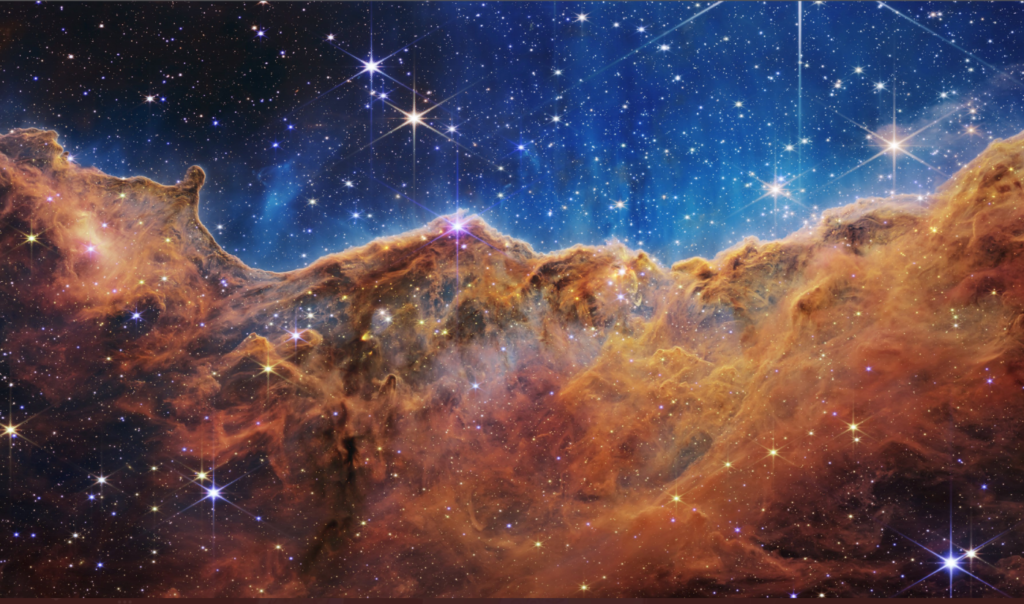
By Munina Lam
JET PROPULSION LABORATORY — It is a slide show like no other.
NASA on Tuesday, July 12, began releasing the full set of full-colored “deep field” images and data of distant galaxies captured by the James Webb Space Telescope, the successor of the Hubble telescope.
But this isn’t your everyday scroll through instagram. No no.. This is the epitome of “A long time ago, in a galaxy far, far away…” — as in what are now snapshots of a corner of the universe, capturing light from more than 13 billion years ago, from swirly white specs, faint galaxies, starlight against the darkness.
These images are showing the farthest humanity has ever peered outward into the stretches of the universe. And on Tuesday, one by one at the Jet Propulsion Laboratory in La Cañada Flintridge, four galactic shots from the telescope’s initial outward gazes were set to mesmerize even the veteran scientists at JPL who contributed to the mission that would bring those images back to Earth.
The “deep field” images — images that were taken with a long exposure time to capture faint objects — were being released simultaneously across several platforms – NASA Television, Youtube, Twitter, Facebook and more.
Among them, a stunning planetary nebula, now known as the Southern Ring Nebula. The Southern Ring, or “Eight-Burst” nebula, is an expanding cloud of gas, surrounding a dying star. It is about approximately 2,000 light years away from Earth.
Some stars go out with a bang. In these images of the Southern Ring planetary nebula, @NASAWebb shows a dying star cloaked by dust and layers of light. Explore this star’s final performance at https://t.co/63zxpNDi4I #UnfoldTheUniverse. pic.twitter.com/dfzrpvrewQ
— NASA (@NASA) July 12, 2022
Then there was a “dance,” of sorts. As NASA described it, the telescope peered through the thick dust of Stephan’s Quintet, a galaxy cluster showing huge shockwaves and tidal tails.
“This is a front-row seat to galactic evolution,” wrote NASA on Twitter.
Stephan’s Quintet, a galaxy cluster showing huge shockwaves and tidal tails.
They include a view of a giant gaseous planet outside our solar system, more images of a nebula where stars are born and die in spectacular beauty and an update of a classic image of five tightly clustered galaxies that dance around each other.
The deepest infrared image of the universe ever taken—the first full-color image from NASA’s Webb Telescope.
Cosmic cliffs & a sea of stars. @NASAWebb reveals baby stars in the Carina Nebula, where ultraviolet radiation and stellar winds shape colossal walls of dust and gas. https://t.co/63zxpNDi4I #UnfoldTheUniverse pic.twitter.com/dXCokBAYGQ
— NASA (@NASA) July 12, 2022
File photo of the James Webb Space Telescope as it was about to begin final assembly at Northrop, (Credit Northrop Grumman Corporation)
Named after NASA’s second administrator James E. Webb, Webb is an international collaborative project between NASA, the European Space Agency and Canadian Space Agency. The $10 billion telescope – the world’s biggest and most powerful – is 21 feet wide and has a sunshield that is a size of a tennis court.
The telescope was rocketed to space last December from French Guiana in South America. It reached its lookout point 1 million miles (1.6 million kilometers) from Earth in January. Then the lengthy process began to align the mirrors, get the infrared detectors cold enough to operate and calibrate the science instruments, all protected by a sunshade the size of a tennis court that keeps the telescope cool.
The plan is to use the telescope to peer back so far that scientists will get a glimpse of the early days of the universe about 13.7 billion years ago and zoom in on closer cosmic objects, even our own solar system, with sharper focus.
Webb will be used to study stars and galaxies that were formed over 13.5 billion years ago with help from its instruments: Near-Infrared Camera (NIRCam), Near-Infrared Spectrograph (NIRSpec), Mid-Infrared Instrument (MIRI), and Near-Infrared Imager and Slitless Spectrograph (NIRISS) with the Fine Guidance Sensor (FGS).
In other words, this is how galaxies looked more than 13 billion years ago.
Researchers can then study how galaxies evolve throughout the years.
The world got a preview on Monday when President Joe Biden unveiled the image of galaxy cluster called SMACS 0723 during a White House event.
Biden marveled at the image that he said showed “the oldest documented light in the history of the universe from over 13 billion — let me say that again — 13 billion years ago. It’s hard to fathom.
NASA administrator Bill Nelson described the image — filled with white, yellow, orange and red swirls, streaks and spirals — as “one little speck of the universe”, according to the Associated Press.
The deep field of SMACS 0723, composited from several different images, took Webb 12.5 hours to produce. In comparison, the same process would have taken its predecessor, Hubble, weeks to achieve.
Vice President Kamala Harris, who is also the chair of the National Space Council, lauded Webb as “one of humanity’s great engineering achievements” at the event, saying, “It will enhance what we know about the origins of our universe, our solar system and, possibly, life itself.”
Biden said that the telescope shows how America can lead by example by participating in an international collaborative effort in discovering more about the planet and climate, symbolizing American ingenuity.
“That’s why the federal government must invest in science and technology more than we have in the past,” he said.
The release of these images marks the start of Webb’s general science operations, where teams of scientists will use the telescope to do research and observations. The teams’ proposals were selected via a rigorous process over the course of the COVID-19 pandemic.
Out of over 1000s proposals, only 286 proposals were selected.
Related links
NASA, local leaders meet at Pasadena’s JPL to discuss future
JPL-made Ingenuity helicopter spots wreckage of Perseverance rover’s landing gear on Mars
Pasadena’s JPL names Laurie Leshin its first woman director
Munina Lam is a freelancer for the Southern California News Group. The Associated Press contributed to this story.
